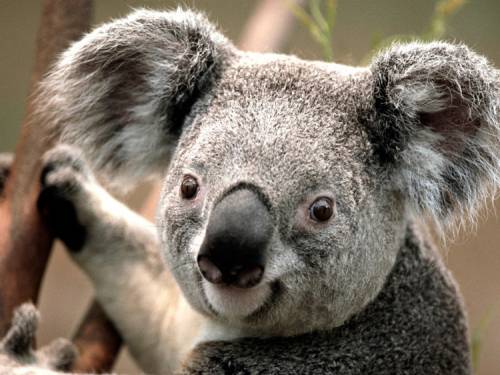The koala is an arboreal herbivorous marsupial native toAustralia. It is the only extant representative of the family Phascolarctidae and its closest living relatives are thewombats. The koala is found in coastal areas of the mainland's eastern and southern regions, inhabiting Queensland,New South Wales, Victoria, and South Australia. It is easily recognisable by its stout, tailless body and large head with round, fluffy ears and large, spoon-shaped nose. The koala has a body length of 60–85 cm (24–33 in) and weighs 4–15 kg (9–33 lb). Pelage colour ranges from silver grey to chocolate brown. Koalas from the northern populations are typically smaller and lighter in colour than their counterparts further south. These populations possibly are separatesubspecies, but this is disputed.
Koalas typically inhabit open eucalypt woodlands, and the leaves of these trees make up most of their diet. Because this eucalypt diet has limited nutritional and caloric content, koalas are largely sedentary and sleep up to 20 hours a day. They are asocial animals, and bonding exists only between mothers and dependent offspring. Adult males communicatewith loud bellows that intimidate rivals and attract mates. Males mark their presence with secretions from scent glandslocated on their chests. Being marsupials, koalas give birth to underdeveloped young that crawl into their mothers'pouches, where they stay for the first six to seven months of their lives. These young koalas, known as joeys, are fullyweaned around a year old. Koalas have few natural predators and parasites, but are threatened by various pathogens, such as Chlamydiaceae bacteria and the koala retrovirus, as well as by bushfires and droughts.
Koalas were hunted by indigenous Australians and depicted in myths and cave art for millennia. The first recorded encounter between a European and a koala was in 1798, and an image of the animal was published in 1810 by naturalist George Perry. Botanist Robert Brown wrote the first detailed scientific description of the koala in 1814, although his work remained unpublished for 180 years. Popular artist John Gould illustrated and described the koala, introducing the species to the general British public. Further details about the animal's biology were revealed in the 19th century by several English scientists. Because of its distinctive appearance, the koala is recognised worldwide as asymbol of Australia. Koalas are listed as of Vulnerable by the International Union for Conservation of Nature.[1] The Australian government similarly lists specific populations in Queensland and New South Wales as Vulnerable.[4] The animal was hunted heavily in the early 20th century for its fur, and large-scale cullings in Queensland resulted in a public outcry that initiated a movement to protect the species. Sanctuaries were established, and translocation efforts moved to new regions koalas whose habitat had become fragmented or reduced. The biggest threat to their existence is habitat destruction caused by agriculture and urbanisation.

1.The boy looked at his sister`s present.But he did not take any sweet.(возможно и could. если он по какой -то причине не смог взять конфету..)
2.Miss Chater could not write the letter yesterday.She was too busy.
3 Did you play this computer game yesterday?-No,we did not.We were in the zoo.
4. Were you at home two hours ago?-Yes,I was.
5.I could not dive last summer.Now I can.